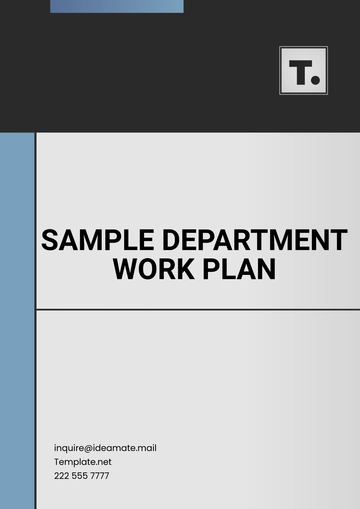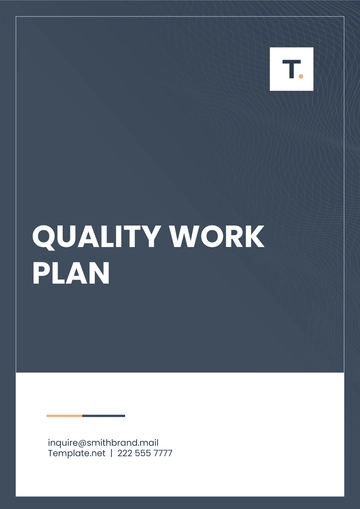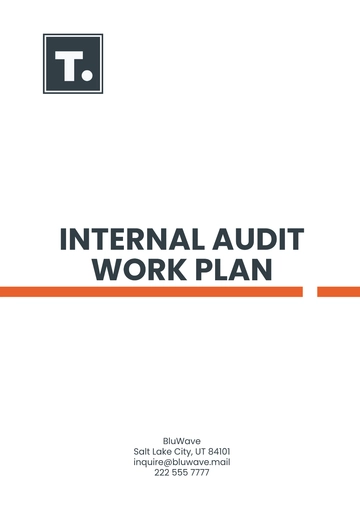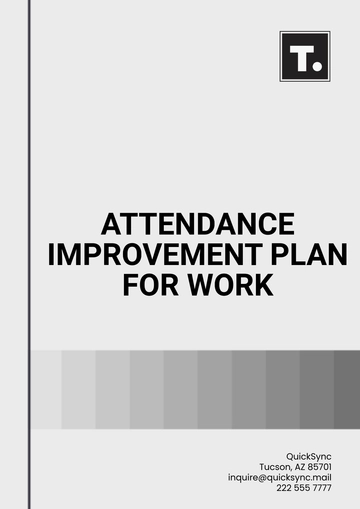Free Farm Work Plan

Prepared By: [Your Name]
Date: [Date]
I. Introduction
This Farm Work Plan delineates the meticulous strategies and activities for ensuring optimal livestock breeding and management on the verdant pastures of [Your Company Name]. Our overarching goal is to harmonize productivity with animal welfare while bolstering profitability.
II. Objectives
Enhance the genetic lineage of our livestock, focusing on traits conducive to robust health and high yield.
Augment reproductive efficiency to amplify the rate of offspring production.
Administer precise nutrition and healthcare protocols tailored to individual animal requirements.
Rationalize resource employment to ensure maximal efficiency and minimize waste.
Mitigate our environmental footprint by implementing sustainable practices.
III. Inventory Assessment
Conduct an exhaustive inventory of our current livestock population, categorizing them by species, breed, age, and sex.
Rigorously evaluate the health status, reproductive history, and genetic lineage of each animal.
Scrutinize existing infrastructure, including barns, paddocks, and feeding facilities, to identify areas for improvement and optimization.
IV. Breeding Program
Employ stringent selection criteria to identify elite breeding stock, emphasizing traits such as milk production, growth rate, and disease resistance.
Implement a meticulous breeding schedule, utilizing techniques such as artificial insemination and selective mating to propagate superior genetic traits.
Employ advanced reproductive technologies, including embryo transfer and genetic screening, to expedite genetic progress.
Maintain meticulous records of breeding activities, encompassing pedigree information, reproductive outcomes, and genetic data.
V. Nutrition and Healthcare
Formulate bespoke nutrition plans tailored to the specific dietary requirements of each livestock group, accounting for factors such as age, breed, and physiological status.
Ensure consistent access to clean water and premium-quality feed sources, supplemented with essential minerals and vitamins.
Institute a comprehensive healthcare regimen, encompassing regular vaccinations, deworming, and proactive disease surveillance.
Conduct routine health assessments, facilitated by qualified veterinarians, to detect and address any emerging health issues promptly.
VI. Facilities and Infrastructure
Optimize existing facilities to accommodate the diverse needs of our growing livestock population, including spacious housing areas and well-ventilated barns.
Fortify perimeter fencing and implement predator deterrents to safeguard our livestock from external threats.
Upgrade infrastructure components, such as feeding systems and water distribution networks, to enhance operational efficiency and animal comfort.
VI. Personnel and Training
Assign specific responsibilities to farm personnel, delineating roles for tasks such as breeding management, healthcare provision, and facility maintenance.
Conduct comprehensive training sessions to equip staff with the requisite skills and knowledge for effective livestock handling, breeding, and management.
Foster a culture of continuous improvement and innovation, encouraging team members to share insights and implement best practices gleaned from industry research and professional development opportunities.
VII. Monitoring and Evaluation
Establish a suite of key performance indicators (KPIs) to quantify progress towards our breeding and management objectives, encompassing metrics such as reproductive rates, mortality rates, and feed conversion efficiency.
Conduct regular performance reviews, leveraging data-driven insights to identify areas for refinement and optimization.
Solicit feedback from farm staff and stakeholders, fostering a collaborative approach to problem-solving and decision-making.
VIII. Environmental Sustainability
Integrate sustainable practices into our operational framework, including rotational grazing, composting, and agroforestry initiatives, to minimize our ecological footprint.
Explore opportunities for renewable energy generation, such as solar panels and methane digesters, to reduce reliance on non-renewable resources.
Engage in ongoing research and collaboration with environmental experts to implement innovative solutions for mitigating climate change and promoting biodiversity.
IX. Budget and Resources
Develop a comprehensive budgetary plan encompassing expenditures for feed, healthcare, infrastructure upgrades, labor, and contingencies.
Allocate resources judiciously to prioritize investments that yield the highest return on investment, balancing immediate needs with long-term sustainability objectives.
Leverage financial forecasting and risk analysis tools to anticipate potential budgetary constraints and proactively mitigate financial risks.
X. Risk Management
Identify potential risks and vulnerabilities inherent in our breeding and management operations, including disease outbreaks, market fluctuations, and adverse weather events.
Develop robust contingency plans and risk mitigation strategies, incorporating measures such as emergency response protocols, insurance coverage, and diversification strategies.
Foster a culture of resilience and adaptability, empowering farm personnel to respond effectively to unforeseen challenges while maintaining a steadfast commitment to our overarching objectives.
XI. Conclusion
Through steadfast adherence to the meticulously crafted strategies outlined in this Farm Work Plan, we are poised to realize our vision of a thriving livestock operation characterized by genetic excellence, operational efficiency, and environmental stewardship. By embracing innovation, collaboration, and continuous improvement, we are confident in our ability to navigate the dynamic landscape of modern agriculture and emerge as a beacon of excellence in the realm of livestock breeding and management.
- 100% Customizable, free editor
- Access 1 Million+ Templates, photo’s & graphics
- Download or share as a template
- Click and replace photos, graphics, text, backgrounds
- Resize, crop, AI write & more
- Access advanced editor
Optimize your farm operations with Template.net's Farm Work Plan Template. Tailored for agricultural efficiency, it's editable and customizable to accommodate seasonal variations and specific requirements. Editable in our Ai Editor Tool, it empowers farmers to plan and manage tasks effectively, maximizing yield and sustainability.
You may also like
- Finance Plan
- Construction Plan
- Sales Plan
- Development Plan
- Career Plan
- Budget Plan
- HR Plan
- Education Plan
- Transition Plan
- Work Plan
- Training Plan
- Communication Plan
- Operation Plan
- Health And Safety Plan
- Strategy Plan
- Professional Development Plan
- Advertising Plan
- Risk Management Plan
- Restaurant Plan
- School Plan
- Nursing Home Patient Care Plan
- Nursing Care Plan
- Plan Event
- Startup Plan
- Social Media Plan
- Staffing Plan
- Annual Plan
- Content Plan
- Payment Plan
- Implementation Plan
- Hotel Plan
- Workout Plan
- Accounting Plan
- Campaign Plan
- Essay Plan
- 30 60 90 Day Plan
- Research Plan
- Recruitment Plan
- 90 Day Plan
- Quarterly Plan
- Emergency Plan
- 5 Year Plan
- Gym Plan
- Personal Plan
- IT and Software Plan
- Treatment Plan
- Real Estate Plan
- Law Firm Plan
- Healthcare Plan
- Improvement Plan
- Media Plan
- 5 Year Business Plan
- Learning Plan
- Marketing Campaign Plan
- Travel Agency Plan
- Cleaning Services Plan
- Interior Design Plan
- Performance Plan
- PR Plan
- Birth Plan
- Life Plan
- SEO Plan
- Disaster Recovery Plan
- Continuity Plan
- Launch Plan
- Legal Plan
- Behavior Plan
- Performance Improvement Plan
- Salon Plan
- Security Plan
- Security Management Plan
- Employee Development Plan
- Quality Plan
- Service Improvement Plan
- Growth Plan
- Incident Response Plan
- Basketball Plan
- Emergency Action Plan
- Product Launch Plan
- Spa Plan
- Employee Training Plan
- Data Analysis Plan
- Employee Action Plan
- Territory Plan
- Audit Plan
- Classroom Plan
- Activity Plan
- Parenting Plan
- Care Plan
- Project Execution Plan
- Exercise Plan
- Internship Plan
- Software Development Plan
- Continuous Improvement Plan
- Leave Plan
- 90 Day Sales Plan
- Advertising Agency Plan
- Employee Transition Plan
- Smart Action Plan
- Workplace Safety Plan
- Behavior Change Plan
- Contingency Plan
- Continuity of Operations Plan
- Health Plan
- Quality Control Plan
- Self Plan
- Sports Development Plan
- Change Management Plan
- Ecommerce Plan
- Personal Financial Plan
- Process Improvement Plan
- 30-60-90 Day Sales Plan
- Crisis Management Plan
- Engagement Plan
- Execution Plan
- Pandemic Plan
- Quality Assurance Plan
- Service Continuity Plan
- Agile Project Plan
- Fundraising Plan
- Job Transition Plan
- Asset Maintenance Plan
- Maintenance Plan
- Software Test Plan
- Staff Training and Development Plan
- 3 Year Plan
- Brand Activation Plan
- Release Plan
- Resource Plan
- Risk Mitigation Plan
- Teacher Plan
- 30 60 90 Day Plan for New Manager
- Food Safety Plan
- Food Truck Plan
- Hiring Plan
- Quality Management Plan
- Wellness Plan
- Behavior Intervention Plan
- Bonus Plan
- Investment Plan
- Maternity Leave Plan
- Pandemic Response Plan
- Succession Planning
- Coaching Plan
- Configuration Management Plan
- Remote Work Plan
- Self Care Plan
- Teaching Plan
- 100-Day Plan
- HACCP Plan
- Student Plan
- Sustainability Plan
- 30 60 90 Day Plan for Interview
- Access Plan
- Site Specific Safety Plan





























